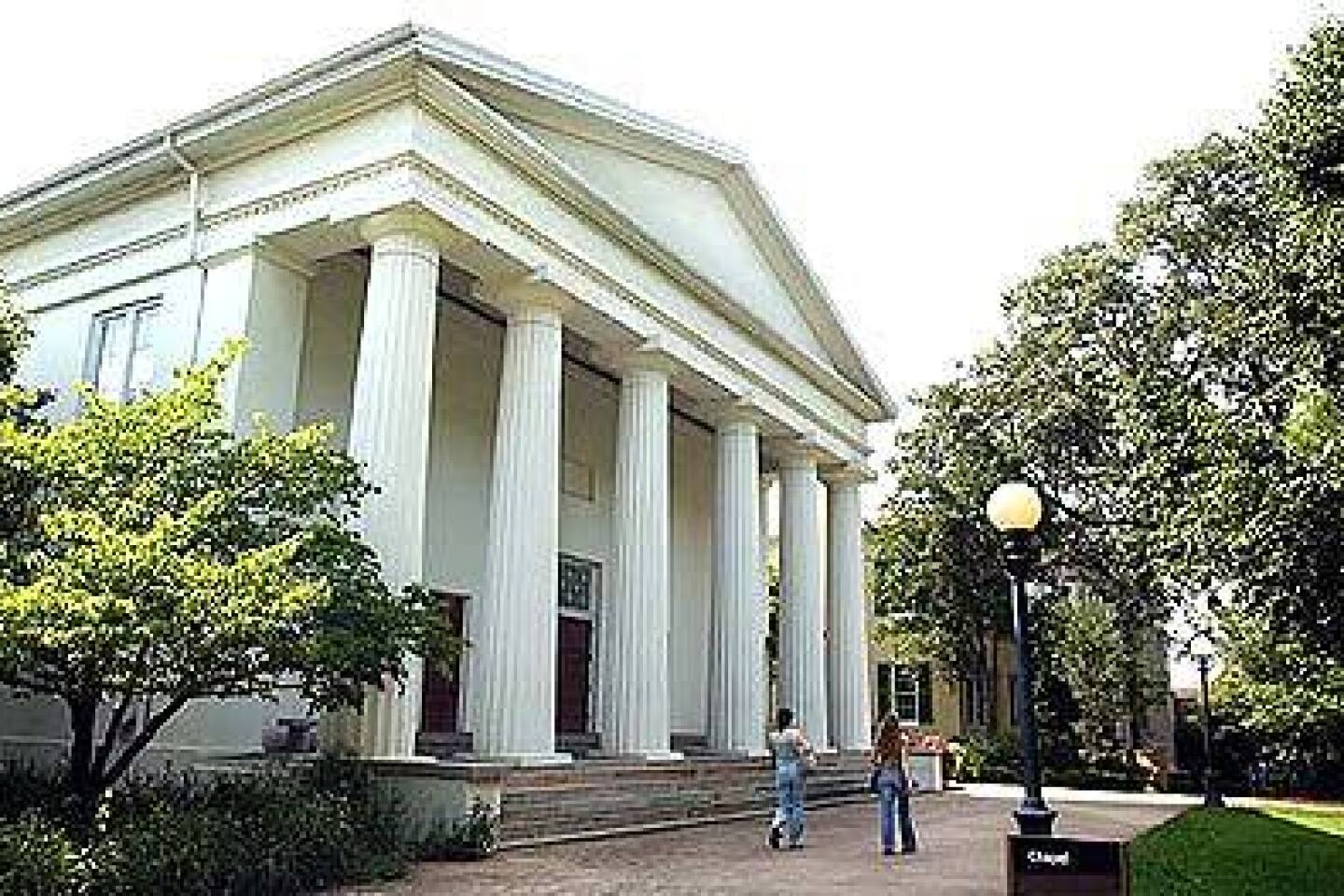A Southern classic
- Share via
Athens, Ga. — They’ve just unleashed the dawgs on the streets of this college town — 36 fanciful fiberglass bulldogs that will be permanent works of public art in and around the historic downtown and on the campus of the University of Georgia, home of the Georgia Bulldogs.
The colorful canines include the Elvis-themed “Ain’t Nothin’ but a Hound Dawg,” a green amphibidawg titled “I Thought You Said Bullfrog” and a toga-clad Caesar Dawgustus.
Chicago had its cows, Seattle its pigs. In Athens it had to be bulldogs — spelled dawgs in these parts. After all, this is the home of Uga (that’s ugh-uh) VI, the university’s white English bulldog mascot.
The dawgs, painted by Athens artists, are a pedestrian-friendly visitor attraction. There were some concerns — unjustified, as it turned out — that the mold for these dawgs was made by Yankees in Chicago. “The main thing,” says Julie Walters, co-chairwoman of “We Let the Dogs Out,” a charity fund-raiser sponsored by the Athens-Oconee Junior Woman’s Club, “was getting the jowls right.”
With or without dawgs, Athens, 65 miles northeast of Atlanta, is a lively city anchored by the 605-acre main university campus. Restaurants, coffee bars and music clubs abound. A downtown guide lists 45 restaurants and 39 other venues as “taverns/entertainment,” so it’s not surprising that the city spawned rock bands R.E.M., the B-52s and Widespread Panic.
My infatuation with Athens began on a balmy Tuesday night in mid-May after I’d checked in at the Foundry Park Inn & Spa, a nicely refurbished former Ramada Inn a few blocks from the town’s center.
Having just flown from L.A. to Atlanta and made the 90-minute drive to Athens, I decided on dinner in the brick-walled patio of the inn’s Athens Steam Co. Pub, in a former foundry. As I ate Cuban chicken, black beans and plantains — all pretty good — a quartet played classic jazz under the stars. Not a table was empty.
Just across Dougherty Street from the inn is the Athens Welcome Center, in the restored 1820 Federal-style Church-Waddel-Brumby House, the city’s oldest residence.
The hourlong Classic City Tour by minivan ($20) begins here at 2 p.m. daily. Well, almost daily. When I stopped by, a crestfallen staffer said the van was ailing and suggested I take the self-guided 1.4-mile downtown walking tour.
Right off, I happened upon a free street concert by a local middle school orchestra that was giving its all for a curb-sitting audience, very homey and small-town. Athens has a small-town ambience, although the exact population is hard to pin down. In 1990, 125-square-mile Athens-Clarke County voted to become one entity. The county population is 105,000, including 32,000 UGA students, and Athens is the county seat — “The Best Seat in the South,” it calls itself.
The day was cool, with a few sprinkles, and I walked for several hours, taking in the Beaux Arts City Hall, with its “Torchlighter” sculpture commemorating Athens’ role as a venue for the 1996 Atlanta Olympics. It was in UGA’s 86,000-seat Sanford Stadium that the U.S. women’s soccer team bested China for the gold medal.
A city of graceful style
Strolling through the iron arch that leads to the north campus and its lovely Greek Revival chapel, I saw some students actually walk around rather than under the landmark. Legend has it that those who walk under it will not graduate.Athens, named for the city in Greece, has a plethora of Greek columns on its buildings, including the 1941 WPA-built post office, the 1913 Athens-Clarke County courthouse, the 1855 First Presbyterian Church and the 1843 Taylor-Grady house, which has 13 Doric columns, thought to symbolize the original 13 Colonies. A marble statue of Athena stands outside the Classic Center, which houses a 2,000-seat theater.
I was intrigued by the giant vegetable patch mural, so I stopped for lunch at the Last Resort Grill, once a 1960s music club where such notables as Jimmy Buffett played. (The story goes that there were once three lending institutions down the street, and those turned down for a loan could try the bar as a last resort.) Ordering crab cakes (good) and iced tea, I was asked — as I would be many times here in the South — if I wanted my tea sweet.
At “Hot Corner,” an early hub of black business at Washington and Hull streets, stands the restored 1910 Morton Theater. A woman at the ticket office agreed to show me around if I would return when she got off-duty. This onetime black vaudeville theater is in a building constructed by Monroe Bowers Morton, the son of a white father and a slave mother. Morton ultimately became U.S. postmaster for Athens. Building tenants once included black doctors and dentists and an undertaker. It’s said that Duke Ellington, Louis Armstrong, Bessie Smith and Cab Calloway played the Morton.
The Morton, with its opal glass bowl lights, pressed metal ceiling and pine floor, is now a 548-seat community performing arts space. It is among historic sites restored through a one-cent local sales tax approved by voters in 1987. Much history was erased in the ‘60s in the name of urban renewal.
Janet Clark, an ardent preservationist who is one of the city tour guides, points to historic homes that have been demolished and replaced by parking lots, small commercial buildings or fake Colonials of no architectural merit. Two examples: the Twin Mansions on Prince Street, built by two brothers at the turn of the century, and a Queen Anne house on the same street that’s been replaced by what Clark calls “a sort of seashore-looking wood building that was initially a pizza parlor” and now is a medical building. Others have given way to apartments to house the 80% of UGA students who do not live on campus.
On the recommendation of locals, I had dinner at Hoyt House, the Foundry Park Inn’s formal restaurant, which opened in August. The waiter told me the 1829 house, which was saved from the wrecking ball by its move to this site, may be haunted by the original owner, who killed himself here.
There was something surreal about being the only diner in this big room with two fireplaces. Too bad, because my sole in lobster broth was excellent and the white asparagus soup a triumph.
Taking a spin out of town
On a rainy day, I drove 28 miles south on the Antebellum Trail, U.S. 441, to lovely little Madison, stopping along the way in Watkinsville, which has antiques and gift shops and Tea Roses, where traditional English tea is served from 10 a.m. to 5 p.m. Wednesdays through Saturdays in rooms strewn with vintage hats and those fur pieces that snap at themselves. (Reservations: [706] 769-0024.) The welcome center, in a former tavern and stagecoach stop dating to 1801, has a little museum with old chests, a spinning wheel and loom and an antique corn sheller. The gift shop sells grits and pecans.Between Watkinsville and Madison, the highway slices through wooded country dotted with roadside stands selling boiled peanuts, peaches and Vidalia onions. Madison, which calls itself “the town Sherman refused to burn” (it seems a local Unionist had influence with the general’s brother), is a picture-postcard place with its brick sidewalks and town square.
The only jarring note is the disconcerting number of cars and trucks whizzing through on magnolia-shaded Main Street. Main and Academy Street, paralleling it, are a feast of antebellum homes. The welcome center on the square is a good starting point for seeing the town, which has 100 structures on the National Register of Historic Places.
Across from Madison’s 1905 Beaux Arts brick courthouse is a plaque noting that Oliver Norvell Hardy (of Laurel and Hardy) once lived on the site. His mother owned a hotel in Madison, and young Oliver attended the grammar school.
Even though it was after hours, Wauline Baptiste answered my knock at the Morgan County African-American Museum at 156 Academy St. The simple four-room house, left to a former slave by his master, displays West African art, drums, masks and clothing and 93 pieces of contemporary Shona sculpture from Zimbabwe.
The Madison-Morgan Cultural Center at 434 S. Main St. is in an 1895 Romanesque Revival building that was a schoolhouse until the mid-1950s. Today it’s sort of a museum within a museum. One room is a re-creation of an 1896 classroom; on the original desks are copies of McGuffey’s Readers, which taught generations of children reading, writing and morality. Another room depicts life in the region 150 years ago. There are tools, a Confederate rifle, a lightning rod, a carpet bag and a pine rope bed.
I couldn’t resist a detour to Social Circle (population 2,755), about 20 minutes west of Madison off Interstate 20. It’s said that an early visitor to this onetime railroad stopover remarked, “This sure is a social circle.” The town, with its vintage storefronts, doesn’t seem to have changed much since 1869, when it was illegal to be out past 10 p.m. It’s home to the Blue Willow Inn at 294 N. Cherokee Road, which serves up bountiful lunch and supper buffets of Southern specialties. The evening I looked in, steam tables were laden with macaroni and cheese, liver and onions, fried chicken and fried green tomatoes. When this Greek Revival mansion was a private home, “Gone With the Wind” author Margaret Mitchell came often with her first husband-to-be, Red Upshaw, a relative of the home’s owner. Rhett Butler is said to be based on him.
I had booked a night at Southern Cross Guest Ranch near Madison, where I was shown to Scarlett O’Hara, a big, comfortable room with lacy curtains and a portrait of Herself.
The ranch house is a brick Colonial that can’t decide whether to be Versailles, France, or Big Sky, Mont. I liked the juxtaposition of Versailles and Big Sky with public rooms awash in Louis-something furnishings.
But it’s also bucolic, with horses, cows, dogs and acres of pasture. There’s a swimming pool and a pond stocked with bass and catfish. The TV room is done up like a Wild West bar. Before leaving, I stopped by the on-site Valhalla Farms stable to see a newborn colt.
The main meal is at noon, a buffet that proprietor Noel Detienne calls “kind of what you’d expect to have at Grandma’s on Sunday.” No alcohol is served, but guests may stash their own in a community fridge. There are mountain bikes and daily horse rides. If I were a kid vacationing with my parents, I think I’d love this place. As a grown-up who’s never had a great relationship with horses, it’s not on my return-to list.
A drive through history
On my last day in Athens I finally took that classic city tour, which includes Milledge Avenue mansions that now are fraternity and sorority houses. We skirted Five Points, where trendy shops and restaurants include Jittery Joe’s coffee spot in a former gas station and the upscale Five and Ten restaurant.We saw historic homes along Dearing Street, one of 14 historic districts with 19th and 20th century buildings. (Athens-Clarke County has 31 homes and other buildings on the National Register of Historic Places.)
I still had time to do part of the self-guided walking tour of historic music sites dear to the hearts of rock fans. Unfortunately, many sites have been demolished or, like the 40 Watt Club, have made multiple moves. St. Mary’s Church, 394 Oconee St., where R.E.M. played its first public gig, has been replaced by condos. The 40 Watt, originally in a space above what is now the Grill at 171 College Ave. (and lighted by a 40-watt bulb), today occupies a former furniture mart at 285 W. Washington St., next to Pain and Wonder tattoo studio.
The Georgia Theater, a former movie house at 215 N. Lumpkin St., is a music hall where headliners have included the Red Hot Chili Peppers, Wynton Marsalis and Hootie and the Blowfish. R.E.M.’s Peter Buck once clerked at Wuxtry Records at 197 E. Clayton St.
Tourism is second only to agriculture in Athens-Clarke County, and the welcome center in Athens is stocked with brochures and maps. A walking guide to the painted bulldogs will soon be available there. As UGA fans say, “Go, Dawgs, sic ‘em!”
More to Read
Sign up for The Wild
We’ll help you find the best places to hike, bike and run, as well as the perfect silent spots for meditation and yoga.
You may occasionally receive promotional content from the Los Angeles Times.











